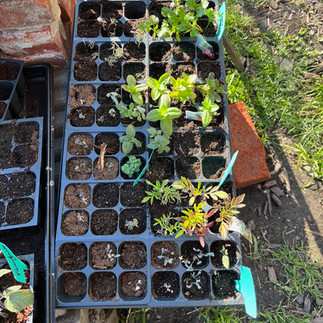Hardening Off Seedlings for Transplant
- Chelsea Stolte

- Apr 14
- 4 min read
Updated: Apr 29
Growing a successful garden starts with the right preparation, especially when transplanting seedlings. A critical step in this journey is hardening off your seedlings. This essential practice prepares your young plants for the big transition from the controlled comfort of your home to the unpredictable outdoor world. By gradually introducing them to their new environment, you ensure they thrive once planted in the garden.
Understanding the Hardening Off Process
Hardening off is the gradual acclimatization of seedlings to outdoor conditions before transplanting. If seedlings spend too much time indoors, they may struggle with outdoor elements like sunlight, wind, and fluctuating temperatures. For instance, seedlings grown under fluorescent lights may have adapted poorly to the bright, direct sunlight outdoors. Hardening them off involves exposing them step-by-step, allowing them to develop the resilience needed for survival in the garden.
The Importance of Hardening Off
Seedlings, though promising, are quite fragile. When exposed to harsh conditions too quickly, they can suffer from transplant shock, which may slow growth or even lead to death. Here’s why hardening off is crucial:
Adapt to Light: Indoor lighting is much softer than outdoor sunlight. Gradually introducing seedlings to natural light minimizes the risk of sunburn. Studies show that seedlings exposed to full sun too quickly can see up to a 30% reduction in growth rates.
Strengthen Stems: Wind exposure helps to strengthen a seedling's structure. Seedlings that spend time in the wind can develop stems that are up to 50% stronger.
Prepare for Temperature Changes: Sudden temperature shifts can shock plants. A gradual introduction helps seedlings adapt better. According to horticultural experts, plants that are hardened off can tolerate temperature changes as much as 10 degrees better than those that aren’t.
Enhance Root Growth: Light and fresh air encourage root development, making the plant stronger. Healthier roots can lead to improved water and nutrient uptake, resulting in more robust plants.
When to Begin the Hardening Off Process
Timing is crucial for hardening off your seedlings. This process should typically begin 1-2 weeks before you plan to transplant. Keep an eye on the weather, as frost can be detrimental. Start hardening off your seedlings when nighttime temperatures consistently stay above 50°F (10°C). This temperature provides a safer transition for young plants.
Step-by-Step Guide to Hardening Off Seedlings
Step 1: Prepare the Outdoor Environment
Choose a sheltered location for your seedlings, such as a porch or patio, where they can get sunlight but also have some protection from harsh winds and extreme temperatures. This area should also be free from pests that could harm them.
Step 2: Start with Short Exposure
On the first day, take your seedlings outside for just 1-2 hours. Start them in a shaded spot to minimize stress. This initial exposure allows them to gradually adjust to natural light and fresh air.

Step 3: Gradually Increase Time Outdoors
Each day, increase the time your seedlings spend outdoors by 1-2 hours. Keep them shaded initially. By the end of the week, they should manage a few hours of direct sunlight each day.
Step 4: Introduce Wind Exposure
After a few days in moderate light, introduce your seedlings to gentle wind. On a day with light breezes, place the seedlings in an open area for brief periods. This exposure strengthens their stems and prepares them for outdoor conditions.
Step 5: Monitor Seedlings
Keep a close eye on your seedlings during the hardening-off process. Look for signs of stress, like yellowing leaves or drooping stems. If you notice any distress or harsh weather conditions, it is perfectly fine to bring them indoors for a day or two.
Step 6: Transition to Full Sunlight
After about a week, or longer for more sensitive plants, your seedlings should be ready for full sun and temperature fluctuations. Once they show signs of health and vitality, they are prepared for transplanting.
Best Practices for Successful Transplanting
Once your seedlings are acclimated, ensure a smooth transition to the garden. Here are several tips to keep in mind:
Choose the Right Time: Aim to transplant on a cool, cloudy day to minimize stress. Early morning or late afternoon is typically the best time.
Water Before Transplanting: Ensure seedlings are well-watered before moving them to their new home. This practice helps minimize shock and stress.
Handle Carefully: When removing seedlings from their containers, be cautious to keep the root system intact. Transplanting into pre-moistened garden soil is essential for successful establishment.
Water After Planting: After transplanting, give your seedlings a thorough watering. This helps settle the soil around the roots.
Provide Initial Shade: If possible, create temporary shade for the first few days after transplanting to protect your seedlings from intense sunlight.
Final Thoughts on Hardening Off Seedlings
Hardening off seedlings is a rewarding process that significantly boosts your garden's success. By allowing your plants to transition seamlessly from indoors to the outdoors, you prepare them for a thriving life in your garden beds. With careful attention and patience, your reward will be a vibrant garden filled with healthy plants flourishing throughout the growing season.
So, gather your seedlings, begin the hardening-off process, and watch your gardening dreams bloom! Happy gardening!
~ DIY With Chelsea















Comments